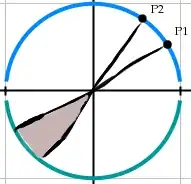We are given a circle with N randomly allocated points on it. Task is to find a chance that all N points lie on the one half of circle.
I have drafted some solution:
1. Since there are no way to put two points on circle, so that they were not on the same half-circle, $P_1$ and $P_2$ picked randomly and didn't affect the chance. So, required probability is:
$P(P_3) \cdot P(P_4)\: \cdot ... \cdot P(P_n)$, where $P(P_i)$ is the chance that i-th point lays on the proper half of circle.
2. Let's visualize what's $P(P_3)$, $P(P_4)$ look like:
Grey sector highlights forbidden part of circle.
It's obvious from pictures, that $P(P_i)$ approaching 0.5 as point amount increases


For this specific example, we could write:
$P(P_3) = 1 - \frac {\Delta(\theta_2,\theta_1)} {2\pi}$ $P(P_4) = 1 - \frac {\Delta(\theta_3,\theta_1)} {2\pi}$.
3. Then if we generalize, $P(P_i) = 1 - \frac {\Delta_i} {2\pi}$, where $\Delta_i$ is a difference of angles of the most distant points.
And I'm understand that here I should introduce some generalized formula but I don't see it and don't want to make guesses. So I would appreciate any help.